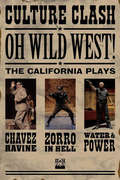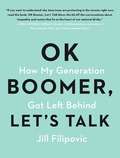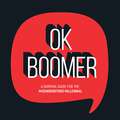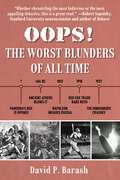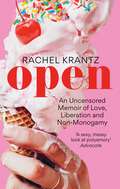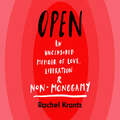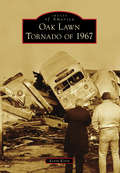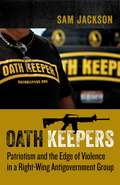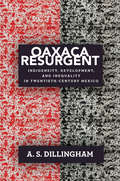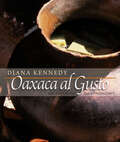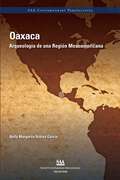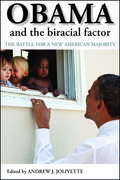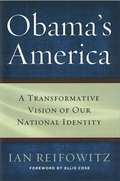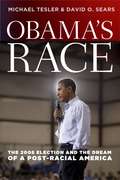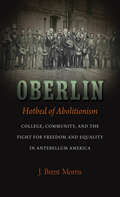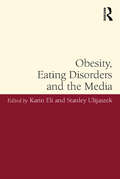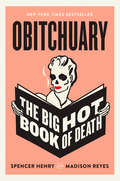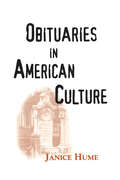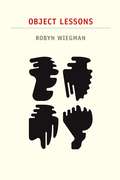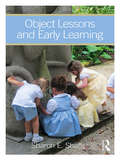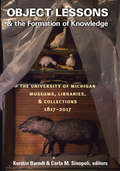- Table View
- List View
OH, WILD WEST!
by Culture Clash"Midway through Water & Power comes a scene so perfectly written, so chilling and yet so hilarious [it] encapsulates all the anger and social criticism fueling [the play], beginning with the agonizing realization (also central to Culture Clash's smash Chavez Ravine) that the fates of the L.A. many are held in the hands of the often capricious and heartless few."--VarietyFor Zorro in Hell:"The funniest show the Bay Area comedy troupe has ever written. Culture Clash uses the story [of Zorro] as a starting point for a devastatingly hilarious satire of just about everything Californians hold dear."--Contra Costa TimesIn this trio of plays, Culture Clash rewrites California's past in the performance troupe's own irreverent comic style, interweaving pop culture with their home state's local history. In Chavez Ravine, called "a hell-raising home run" by Variety, they cover the land grab that uprooted an entire community and built Dodger Stadium. In Water & Power, the topic is the assimilation of Latinos and their rise to political influence. And in Zorro in Hell, Culture Clash re-imagines early California through the eyes of the original masked man.Culture Clash is Richard Montoya, Ric Salinas, and Herbert Siguenza. Founded in San Francisco's Mission District on Cinco de Mayo in 1984, they have become the most prominent Chicano/Latino performance troupe in the United States. Their work ranges from sketch comedy to full-length plays and adaptations of Greek classics, and has been produced at universities and theaters throughout the country.
OK Boomer, Let's Talk: How My Generation Got Left Behind
by Jill Filipovic&“If you want to understand why Americans are protesting in the streets right now, read this book. OK Boomer, Let&’s Talk blows the lid off the conversations about inequality and racism that lie at the heart of our national divide.&” —Jose Antonio Vargas, founder of Define American and author of Dear America: Notes of an Undocumented Citizen &“Jill Filipovic cuts through the noise with characteristic clarity and nuance. Behind the meme is a thoughtfully reported book that greatly contributes to our understanding of generational change.&” —Irin Carmon, coauthor of the New York Times bestseller Notorious RBG Baby Boomers are the most prosperous generation in American history, but their kids are screwed. In this eye-opening book, journalist Jill Filipovic breaks down the massive problems facing Millennials including climate, money, housing, and healthcare. In Ok Boomer, Let&’s Talk, journalist (and Millennial) Jill Filipovic tells the definitive story of her generation—and it&’s no joke. Talking to gig workers, economists, policy makers, and dozens of struggling Millennials drowning in debt on a planet quite literally in flames, Filipovic paints a shocking and nuanced portrait of a generation being left behind: -Millennials are the most educated generation in American history—and also the most broke. -Millennials hold just 3 percent of American wealth. When they were the same age, Boomers held 21 percent. -The average older Millennial has $15,000 in student loan debt. The average Boomer at the same age? Just $2,300 in today&’s dollars. -Millennials are paying almost 40 percent more for their first homes than Boomers did. -American families spend twice as much on healthcare now than they did when Boomers were young parents. Filipovic shows that Millennials are not the avocado-toast-eating snowflakes of Boomer outrage fantasies. But they are the first American generation that will do worse than their parents. &“OK, Boomer&” isn&’t just a sarcastic dismissal—it&’s a recognition that Millennials are in crisis, and that Boomer voters, bankers, and policy makers are responsible. Filipovic goes beyond the meme, upending dated assumptions with revelatory data and revealing portraits of young people delaying adulthood to pay down debt, obsessed with &“wellness&” because they can&’t afford real healthcare, and struggling to #hustle in the precarious gig economy. Ok Boomer, Let&’s Talk is at once an explainer and an extended olive branch that will finally allow these two generations to truly understand each other.
OK Boomer: A Survival Guide for the Misunderstood Millennial
by Summersdale PublishersEveryday life is a battle that must be fought against the boomers, and OK Boomer is the ultimate comeback! This is the lethal weapon we millennial and Gen Zs have been waiting for. It’s the verbal eye-roll we need for the out-of-touch generation who just don’t appreciate avocado and rosé. This amusing little book will advise you when "OK Boomer" can best be deployed, along with tips on recognizing the boomer and understanding their outdated sayings.
OK Boomer: A Survival Guide for the Misunderstood Millennial
by Summersdale PublishersEveryday life is a battle that must be fought against the boomers, and OK Boomer is the ultimate comeback! This is the lethal weapon we millennial and Gen Zs have been waiting for. It’s the verbal eye-roll we need for the out-of-touch generation who just don’t appreciate avocado and rosé. This amusing little book will advise you when "OK Boomer" can best be deployed, along with tips on recognizing the boomer and understanding their outdated sayings.
OK, Boomer: Using a Landline, Going to the Post Office, and Other Outdated Things You Don't Need Anymore
by Tiller PressA book of classic, hilarious &“OK, Boomer&”-isms, a perfect gift for the Baby Boomers we all know and love. Going to the bank. Leaving voicemails. Making Jell-O molds. Using encyclopedias. Wallpapering bathrooms. There are dozens of ridiculously antiquated items, activities, and phrases that Baby Boomers love—and don&’t realize have been outdated for more than a decade. And for some reason, no matter how hard Millennials and Gen Zers try to bring Boomers into the 21st century, they still don&’t seem to get it. They just can&’t let go of eating meatloaf, going on cruises, or buying fuzzy toilet seat covers. So rather than try to explain something to the Baby Boomers in your life, it might be time to just say, &“OK, Boomer.&” Containing more than fifty of the most common, cliched, and cringe-worthy Boomer-isms, OK, Boomer is a perfect gift for any exasperated Millennial or any Boomer willing to poke fun at themselves.
OOPS!: The Worst Blunders of All Time
by David P. BarashTravel through history and around the world to learn about the greatest mistakes, blunders, and bloopers of all time! Everyone makes mistakes and nearly everyone likes to know about them, especially when made by someone else! The Worst Blunders of All Time: Shocking Tales from Pandora's Box to Putin's Invasion presents some of our most notable blunders, from the silly to the consequential, from ancient history to current events. It offers the pleasure of Schadenfreude and of an easy-going reading experience, as well as—here and there—some learning opportunities. The reader will see when relatively big things have gone wrong and couldn&’t be called back, such as iconic, mythical blunders like Pandora opening that troublesome box and Eve taking her ill-advised bite, to great historical oops such as Napoleon&’s invasion of Russia in 1812, as well as some less monumental but nonetheless exemplary mistakes, such as the &“Curse of the Bambino,&” when the Boston Red Sox sold Babe Ruth—at the time, a pitcher—to the New York Yankees. These and other exemplary oops are presented in a light-hearted way, with some exceptions being catastrophic, current catastrophes, such as Trump&’s egregious mishandling of the COVID-19 pandemic. Author David P. Barash will take readers from the tragic to the whimsical, with the latter represented by, for example, &“Wrong Way Corrigan,&” an early twentieth century aviator who thought he was flying nonstop from New York to California, but, confused by a heavy fog, ended up in Ireland. Pointing out these and other mistakes will be an exercise in Monday morning quarterbacking and 20-20 hindsight. Thus, The Worst Blunders of All Time shall &“backstrapolate&”: looking in the rear-view mirror at mistakes made by others.The Worst Blunders of All Time is neither an advice book nor a series of cautionary tales. It&’s an easy and accessible read, especially useful as therapy in these difficult times. However, its nonetheless accurate and informative, giving rise to some potentially useful take-home messages, keyed to its material. Ideally, we should all benefit from our own mistakes, making lemonade out of lemons, while also following Eleanor Roosevelt&’s advice: &“Learn from the mistakes of others. You cannot live long enough to make them all yourself.&”
OPEN: An Uncensored Memoir of Love, Liberation and Non-Monogamy
by Rachel Krantz*****'A starkly naked story of a young woman's adventure of self-discovery, told with a striking lack of shame or apology. Highly recommended.' - Dr. Christopher Ryan, author of Sex At Dawn'Smart, original, ambitious, and deeply absorbing memoir... She succeeds by bringing us deftly and irresistibly into her most intimate pains and joys, stretching our understanding of what commitment and autonomy mean.' - Dr. Wednesday Martin, author of Untrue & Primates of Park Avenue'A perfect guide to our new world, the only problem I had picking up this book was putting it back down. Open compels, entertains, and may ultimately transform its readers.' - Dr. Terry Real, internationally recognised Family Therapist, author, and founder of the Relational Life Institute When Rachel Krantz met and fell for Adam, he told her that he was looking for a committed partnership - just one that did not include exclusivity.Excited but a little trepidatious, Rachel set out to see whether love and a serious relationship can coexist beyond the familiar borders of monogamy. This is her open and honest true story.Now, in her debut memoir, she chronicles her dive into non-monogamy. With fly-on-the-wall detail and extraordinary perceptiveness, OPEN takes us inside Brooklyn parties and into the wider swinger and polyamory community. Armed with her journalistic instincts, detailed journal entries and interviews with experts and therapists, Krantz also breaks new ground in confronting the unique ways tacit abuse and gaslighting can manifest when things get so complex.Unflinching and brazen, OPEN asks what liberation really looks like, and whether the pleasure really is worth the pain.
OPEN: An Uncensored Memoir of Love, Liberation and Non-Monogamy
by Rachel Krantz*****When Rachel Krantz met and fell for Adam, he told her that he was looking for a committed partnership - just one that did not include exclusivity.Excited but a little trepidatious, Rachel set out to see whether love and a serious relationship can coexist beyond the familiar borders of monogamy. This is her open and honest true story.Now, in her debut memoir, she chronicles her dive into non-monogamy. With fly-on-the-wall detail and extraordinary perceptiveness, OPEN takes us inside Brooklyn parties and into the wider swinger and polyamory community. Armed with her journalistic instincts, detailed journal entries and interviews with experts and therapists, Krantz also breaks new ground in confronting the unique ways tacit abuse and gaslighting can manifest when things get so complex.Unflinching and brazen, OPEN asks what liberation really looks like, and whether the pleasure really is worth the pain.(p) Octopus Publishing Group 2022
Oak Lawn Tornado of 1967
by Kevin KorstThe morning of April 21, 1967, was crisp and clear, marking the arrival of spring. As the day progressed, dark clouds covered the skies over Oak Lawn, and a deadly tornado touched down in the village just before 5:30 p.m. Cutting through the intersection of 95th Street and Southwest Highway and striking elsewhere, the storm left mountains of debris and over 30 people dead in its wake. Oak Lawn Community High School, St. Gerald Catholic Church, and the Fairway Super Mart were among the structures damaged or destroyed by the high winds. After the disaster, rescue workers and volunteers poured into Oak Lawn to search for survivors, while Christ Community Hospital and other institutions treated more than 400 injured people. The immense cleanup, which took weeks to complete, saw debris hauled out or disposed of in controlled fires. Despite the scope of the devastation, many of the affected structures were repaired or rebuilt within 12 months.
Oakland's Chinatown (Images of America)
by William WongOakland's Chinatown has a history every bit as compelling as its more famous neighbor across San Francisco Bay. Chinese have been a presence in Oakland since the 1850s, bringing with them a rich and complex tradition that survived legalized discrimination that lingered until the 1950s. Once confined to a small area of downtown where restaurants stir-fried, laundries steamed, and vegetable stands crowded the sidewalks, Chinese gradually moved out into every area of Oakland, and the stands evolved into corner groceries that cemented entire neighborhoods. Chinese helped Oakland grow into a modern business and cultural center and have gained prominence in every aspect of the city's commerce, politics, and arts.
Oath Keepers: Patriotism and the Edge of Violence in a Right-Wing Antigovernment Group
by Professor Sam JacksonSince 2008, the American patriot/militia movement—right-wing antigovernment groups who portray themselves as fighting encroaching tyranny—has grown exponentially. Oath Keepers is among the most visible and vocal of these organizations. Formed in 2009, Oath Keepers gained notoriety for its involvement in the Bundy Ranch standoff of 2014 and the Malheur Refuge occupation of 2016. The group gives voice to a recurrent form of American politics: virulent distrust of the government combined with a valorization of violence.Sam Jackson takes readers inside the world of the most prominent antigovernment group in the United States, examining its extensive online presence to discover how it builds support for its political goals and actions. Through an extensive textual analysis of the group’s publications, Jackson explores how Oath Keepers draws on core American political values and pivotal historical moments of conflict and crisis from the Revolutionary War to Waco to Hurricane Katrina to cast its adherents as defenders of liberty. He details how Oath Keepers makes sense of the contemporary United States, how it provides members with models of political behavior, and how it lobbies the wider American public to join the group. The first book-length investigation of the contemporary patriot/militia movement, Oath Keepers sheds new light on what animates groups that pose a growing threat to American security and political culture.
Oaxaca Resurgent: Indigeneity, Development, and Inequality in Twentieth-Century Mexico
by A. S. DillinghamOaxaca Resurgent examines how Indigenous people in one of Mexico's most rebellious states shaped local and national politics during the twentieth century. Drawing on declassified surveillance documents and original ethnographic research, A. S. Dillingham traces the contested history of indigenous development and the trajectory of the Mexican government's Instituto Nacional Indigenista, the most ambitious agency of its kind in the Americas. This book shows how generations of Indigenous actors, operating from within the Mexican government while also challenging its authority, proved instrumental in democratizing the local teachers' trade union and implementing bilingual education. Focusing on the experiences of anthropologists, government bureaucrats, trade unionists, and activists, Dillingham explores the relationship between indigeneity, rural education and development, and the political radicalism of the Global Sixties. By centering Indigenous expressions of anticolonialism, Oaxaca Resurgent offers key insights into the entangled histories of Indigenous resurgence movements and the rise of state-sponsored multiculturalism in the Americas. This revelatory book provides crucial context for understanding post-1968 Mexican history and the rise of the 2006 Oaxacan social movement.
Oaxaca al Gusto: An Infinite Gastronomy (The William and Bettye Nowlin Series in Art, History, and Culture of the Western Hemisphere)
by Diana KennedyNo one has done more to introduce the world to the authentic, flavorful cuisines of Mexico than Diana Kennedy. Acclaimed as the Julia Child of Mexican cooking, Kennedy has been an intrepid, indefatigable student of Mexican foodways for more than fifty years and has published several classic books on the subject, including The Cuisines of Mexico (now available in The Essential Cuisines of Mexico, a compilation of her first three books), The Art of Mexican Cooking, My Mexico, and From My Mexican Kitchen. Her uncompromising insistence on using the proper local ingredients and preparation techniques has taught generations of cooks how to prepare-and savor-the delicious, subtle, and varied tastes of Mexico. In Oaxaca al Gusto, Kennedy takes us on an amazing journey into one of the most outstanding and colorful cuisines in the world. The state of Oaxaca is one of the most diverse in Mexico, with many different cultural and linguistic groups, often living in areas difficult to access. Each group has its own distinctive cuisine, and Diana Kennedy has spent many years traveling the length and breadth of Oaxaca to record in words and photographs "these little-known foods, both wild and cultivated, the way they were prepared, and the part they play in the daily or festive life of the communities I visited. " Oaxaca al Gusto is the fruit of these labors-and the culmination of Diana Kennedy's life's work. Organized by regions, Oaxaca al Gusto presents some three hundred recipes-most from home cooks-for traditional Oaxacan dishes. Kennedy accompanies each recipe with fascinating notes about the ingredients, cooking techniques, and the food's place in family and communal life. Lovely color photographs illustrate the food and its preparation. A special feature of the book is a chapter devoted to the three pillars of the Oaxacan regional cuisines-chocolate, corn, and chiles. Notes to the cook, a glossary, a bibliography, and an index complete the volume. An irreplaceable record of the infinite world of Oaxacan gastronomy, Oaxaca al Gusto belongs on the shelf of everyone who treasures the world's traditional regional cuisines.
Oaxaca: Arqueología de una Región Mesoamericana (SAA Current Perspectives)
by Nelly M. Robles GarcíaEste libro (SAA Press Current Perspectives Series) ofrece una visión general de la arqueología de la región oaxaqueña, abordada desde sus orígenes, con los científicos del siglo XIX, hasta los estudios más recientes en la época moderna. Ubicada en el sur de México, esta región mesoamericana ha sido considerada como cuna de civilizaciones debido a su ininterrumpido desarrollo cultural, desde la prehistoria hasta nuestros días. El libro se presenta organizado en una manera cronológica, a fin de que el lector pueda comprender el desarrollo de las antiguas culturas que han convivido a lo largo de varios siglos en este agreste territorio. Ofrece una compilación de los conocimientos emanados de los varios proyectos arqueológicos que se han realizado permanentemente en Oaxaca, que han permitido ir construyendo la historia de los grupos humanos asentados desde la etapa lítica hasta la llegada de la conquista europea en las diversas sub-regiones. Muestra también los diversos enfoques de la arqueología mexicana y norteamericana que la han modelado, y que se han complementado de manera afortunada para hacer de Oaxaca una de las regiones más estudiadas de Mesoamérica.
Obama and the Biracial Factor: The Battle for a New American Majority
by Andrew J. JolivetteSince the election in 2008 of Barack Obama to the Presidency of the United States there have been a plethora of books, films, and articles about the role of race in the election of the first person of color to the White House. None of these works though delves into the intricacies of Mr. Obama's biracial background and what it means. Obama and the Biracial Factor is the first book to explore the significance of mixed-race identity as a key factor in the election of President Obama and examines the sociological and political relationship between race, power, and public policy in the United States with an emphasis on public discourse and ethnic representation in his election . Jolivette and his co-authors bring biracial identity and multiraciality to forefront of our understanding of racial projects since his election. Additionally the authors assert the salience of mixed-race identity in U.S. policy and the on-going impact of the media and popular culture on the development, implementation, and interpretation of government policy and ethnic relations in the U.S. and globally. Obama and the Biracial Factor speaks to a wide array of academic disciplines ranging from political science and public policy to sociology and ethnic studies.
Obama's America: A Transformative Vision of Our National Identity
by Ian ReifowitzOur national identity is defined by what it means to be an American and whom we include and why when we talk about "the American people. " A country's national identity is fluid, and Ian Reifowitz argues that President Barack Obama, by emphasizing the ideals Americans hold dear, hopes to redefine ours in a fundamental way. Obama's conception of America emphasizes two principles of national unity: First, all Americans, regardless of their heritage and cultural traditions, should identify with America as their country, based upon shared democratic values, a shared history, and a shared fate. Second, America should embrace all its citizens as active participants in one "family. " Reifowitz explores Obama's belief that strengthening our common bonds will encourage Americans to rectify the injustices and heal the racial divisions that still plague our country. We have the opportunity to demonstrate to the world that a society of many races and cultures can truly become one people. In facing terrorism, violent fundamentalism, and other security issues, Obama's response centers on a powerful, inspiring, and truly inclusive American narrative. By bolstering America's identity as diverse yet unified, he aims both to counter the anxieties and fears that radicalism stokes and give proponents of religious and political freedom a model they can defend. The stakes couldn't be any higher in determining America's future.
Obama's Race: The 2008 Election and the Dream of a Post-Racial America
by Michael Tesler David O. SearsBarack Obama's presidential victory naturally led people to believe that the United States might finally be moving into a post-racial era. Obama's Race--and its eye-opening account of the role played by race in the election--paints a dramatically different picture. The authors argue that the 2008 election was more polarized by racial attitudes than any other presidential election on record--and perhaps more significantly, that there were two sides to this racialization: resentful opposition to and racially liberal support for Obama. As Obama's campaign was given a boost in the primaries from racial liberals that extended well beyond that usually offered to ideologically similar white candidates, Hillary Clinton lost much of her longstanding support and instead became the preferred candidate of Democratic racial conservatives. Time and again, voters' racial predispositions trumped their ideological preferences as John McCain--seldom described as conservative in matters of race--became the darling of racial conservatives from both parties. Hard-hitting and sure to be controversial, Obama's Race will be both praised and criticized--but certainly not ignored.
Oberlin, Hotbed of Abolitionism: College, Community, and the Fight for Freedom and Equality in Antebellum America
by J. Brent MorrisBy exploring the role of Oberlin--the college and the community--in fighting against slavery and for social equality, J. Brent Morris establishes this "hotbed of abolitionism" as the core of the antislavery movement in the West and as one of the most influential reform groups in antebellum America. As the first college to admit men and women of all races, and with a faculty and community comprised of outspoken abolitionists, Oberlin supported a cadre of activist missionaries devoted to emancipation, even if that was through unconventional methods or via an abandonment of strict ideological consistency. Their philosophy was a color-blind composite of various schools of antislavery thought aimed at supporting the best hope of success. Though historians have embraced Oberlin as a potent symbol of egalitarianism, radicalism, and religious zeal, Morris is the first to portray the complete history behind this iconic antislavery symbol.In this book, Morris shifts the focus of generations of antislavery scholarship from the East and demonstrates that the West's influence was largely responsible for a continuous infusion of radicalism that helped the movement stay true to its most progressive principles.
Obesity, Eating Disorders and the Media
by Stanley Ulijaszek Karin EliHow do the media represent obesity and eating disorders? How are these representations related to one another? And how do the news media select which scientific findings and policy decisions to report? Multi-disciplinary in approach, Obesity, Eating Disorders and the Media presents critical new perspectives on media representations of obesity and eating disorders, with analyses of print, online, and televisual media framings. Exploring abjection and alarm as the common themes linking media framings of obesity and eating disorders, Obesity, Eating Disorders and the Media shows how the media similarly position these conditions as dangerous extremes of body size and food practice. The volume then investigates how news media selectively cover and represent science and policy concerning obesity and eating disorders, with close attention to the influence of pre-existing framings alongside institutional and moral agendas. A rich, comprehensive analysis of media framings of obesity and eating disorders - as embodied conditions, complex disorders, public health concerns, and culturally significant phenomena - this volume will be of interest to scholars and students across the social sciences and all those interested in understanding cultural aspects of obesity and eating disorders.
Obfuscation: A User's Guide for Privacy and Protest (The\mit Press Ser.)
by Helen Nissenbaum Finn BruntonHow we can evade, protest, and sabotage today's pervasive digital surveillance by deploying more data, not less—and why we should.With Obfuscation, Finn Brunton and Helen Nissenbaum mean to start a revolution. They are calling us not to the barricades but to our computers, offering us ways to fight today's pervasive digital surveillance—the collection of our data by governments, corporations, advertisers, and hackers. To the toolkit of privacy protecting techniques and projects, they propose adding obfuscation: the deliberate use of ambiguous, confusing, or misleading information to interfere with surveillance and data collection projects. Brunton and Nissenbaum provide tools and a rationale for evasion, noncompliance, refusal, even sabotage—especially for average users, those of us not in a position to opt out or exert control over data about ourselves. Obfuscation will teach users to push back, software developers to keep their user data safe, and policy makers to gather data without misusing it.Brunton and Nissenbaum present a guide to the forms and formats that obfuscation has taken and explain how to craft its implementation to suit the goal and the adversary. They describe a series of historical and contemporary examples, including radar chaff deployed by World War II pilots, Twitter bots that hobbled the social media strategy of popular protest movements, and software that can camouflage users' search queries and stymie online advertising. They go on to consider obfuscation in more general terms, discussing why obfuscation is necessary, whether it is justified, how it works, and how it can be integrated with other privacy practices and technologies.
Obitchuary: The Big Hot Book of Death
by Spencer Henry Madison ReyesBased on the popular podcast, Obitchuary: The Big Hot Book of Death is a smart, funny look at the American culture of death and how we&’re remembered. It&’s safe to say everyone thinks about death—whether they want to or not. But have you ever wondered about what sort of keepsakes you can make with your remains, or given any thought to the most scandalous deathbed confessions throughout history? Well Madison Reyes and Spencer Henry have, and they've spent countless hours scouring the darkest corners of the internet, digging through newspaper archives, devouring documents, and picking the brains of death industry experts to bring you Obitchuary, a darkly funny and deeply poignant exploration of all things death. With chapters like &“Coffin Confessions,&” &“Executions to Die For,&” &“The Last Word,&” and &“If These Dolls Could Speak,&” Madison and Spencer guide us through surprisingly colorful history, traditions, and contemporary practices. They also demystify taboo topics with incredible and hilarious details, including FUNerals, as they call them, cremations and themed funerals, famous body snatchers, and so much more. Shocking, macabre, hilarious, and moving, Obitchuary digs deep into the physical aspects of death while also carefully exploring what death says about our humanity and the ways we choose to remember those we've lost. So go ahead, crack open the book—we know you're dying to read it.
Obituaries in American Culture
by Janice Hume“Within the short period of a year, she was a bride, a beloved wife and companion, a mother, a corpse,” reported The National Intelligencer on the death of Elizabeth Buchanan in 1838. Such obituaries fascinate us. Few of us realize that, when examined historically, they can reveal not only information about the departed but also much about American culture and about who and what we value. They also offer hints about the way Americans view death. This book also will fascinate, for it surveys more than 8,000 newspaper obituaries from 1818 to 1930 to show what they reveal about our culture. It shows how, in memorializing individual citizens, obituaries make a public expression of our values. Far from being staid or morbid, these death notices offer a lively look at a changing America. Indeed, obits are little windows through which to view America's cultural history. In the nineteenth century, they spoke of a person's character, in the twentieth of a person's work and wealth. In the days when women were valued mainly in their relationships with men, their obituaries were about the men in their lives. Then, as now, important friendships make a difference, for sometimes a death has been deemed newsworthy only because of whom the deceased knew. In 1838 when a fifty-year-old Virginian named William P. Custis died “after a long and wasting illness,” readers of The Daily National Intelligencer learned about his generous hospitality, his sterling business principles, and his kindness as a neighbor and husband. Custis's obituary not only recorded the fact of his death but also celebrated his virtues. The newspaper obituary has a commemorative role. It distills the essence of a citizen's life, and it reflects what society values and wants to remember about the deceased. Throughout our history, these published accounts have revealed changing values. They provide a link between public remembrances of individuals and the collective memory of a great American past. In obits of yesteryear, men were brave, gallant, vigilant, bold, honest, and dutiful. Women were patient, resigned, obedient, affectionate, amiable, pious, gentle, virtuous, tender, and useful. Mining newspapers of New York City, New Orleans, Baltimore, Chicago, and San Francisco, along with two early national papers, Niles' Weekly Register and The National Intelligencer, Janice Hume has produced a portrait of America, an entertaining history, and a revealing look at the things Americans have valued.
Object Lessons
by Robyn WiegmanNo concept has been more central to the emergence and evolution of identity studies than social justice. In historical and theoretical accounts, it crystallizes the progressive politics that have shaped the academic study of race, gender, and sexuality. Yet few scholars have deliberated directly on the political agency that notions of justice confer on critical practice. In Object Lessons, Robyn Wiegman contemplates this lack of attention, offering the first sustained inquiry into the political desire that galvanizes identity fields. In each chapter, she examines a key debate by considering the political aspirations that shape it. Addressing Women's Studies, she traces the ways that "gender" promises to overcome the exclusions of "women." Turning to Ethnic Studies, she examines the deconstruction of "whiteness" as an antiracist methodology. As she explores American Studies, she links internationalization to the broader quest for noncomplicity in contemporary criticism. Her analysis of Queer Studies demonstrates how the commitment to antinormativity normalizes the field. In the penultimate chapter, Wiegman addresses intersectionality as the most coveted theoretical approach to political resolution in all of these fields.
Object Lessons and Early Learning
by Sharon E. ShafferThe twenty-first century is a time of change for early learning in museums, due in part to society's evolving view of childhood, from an age of innocence to understanding the robust learning that defines the first years of life. This perspective is a catalyst for international conversation and continues to raise attention and interest across society. Object Lessons and Early Learning leverages what is known about the cognitive development of young children to examine the power of learning through objects in museum and heritage settings. Exploring the history and modern day practice of object-based learning, Shaffer outlines the rationale for endorsing this approach in both formal and informal learning spaces. She argues that museums, as collecting institutions, are learning spaces uniquely positioned to allow children to make meaning about their world through personal connections to cultural artifacts, natural specimens, and works of art. A range of descriptive object lessons, inspired by objects in museums as well as from the everyday world, are presented throughout the text as examples of ways in which children can be encouraged to engage with museum collections. Object Lessons and Early Learning offers insights into strategies for engaging young children as learners in museum settings and in their everyday world, and, as such, will be essential reading for museum professionals, classroom educators, and students. It should also be of great interest to academics and researchers engaged in the study of museums and education.
Object Lessons and the Formation of Knowledge: The University of Michigan Museums, Libraries, and Collections 1817–2017
by Kerstin Barndt Carla M SinopoliObject Lessons and the Formation of Knowledge explores the museums, libraries, and special collections of the University of Michigan on its bicentennial. Since its inception, U-M has collected and preserved objects: biological and geological specimens; ethnographic and archaeological artifacts; photographs and artistic works; encyclopedia, textbooks, rare books, and documents; and many other items. These vast collections and libraries testify to an ambitious vision of the research university as a place where knowledge is accumulated, shared, and disseminated through teaching, exhibition, and publication. Today, two hundred years after the university’s founding, museums, libraries, and archives continue to be an important part of U-M, which maintains more than twenty distinct museums, libraries, and collections. Viewed from a historic perspective, they provide a window through which we can explore the transformation of the academy, its public role, and the development of scholarly disciplines over the last two centuries. Even as they speak to important facets of Michigan’s history, many of these collections also remain essential to academic research, knowledge production, and object-based pedagogy. Moreover, the university’s exhibitions and displays attract hundreds of thousands of visitors per year from the campus, regional, and global communities. Beautifully illustrated with color photographs of these world-renowned collections, this book will appeal to readers interested in the history of museums and collections, the formation of academic disciplines, and of course the University of Michigan.
